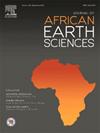基于改进双曲正切滤波器的势场边缘识别方法在势场数据中的应用——以马达加斯加为例
IF 2.2
4区 地球科学
Q2 GEOSCIENCES, MULTIDISCIPLINARY
引用次数: 0
摘要
基于重磁场数据的边缘识别方法由于其独特的优势,在断层和岩体边界识别方面得到了广泛的应用。现有的边缘识别方法往往难以有效平衡不同埋深地质体产生的异常振幅,导致边缘识别结果分辨率下降。为了克服这些问题,提出了一种基于带调节因子α的双曲正切函数和位场数据水平梯度正则化导数的边缘识别方法。通过重磁综合模型测试,我们发现所提出的滤波器与其他常用的方法相比具有更好的性能,可以平衡异常信号并避免伪边界的产生。最后,我们成功地利用该方法研究了马达加斯加岛及其邻近地区的主要断层分布特征。通过综合算例和马达加斯加岛的实际算例,验证了IHRHG滤波器的有效性和实用性。IHRHG滤波器的主要优点是该方法可以同时勾勒出位于不同深度的边界,其检测结果清晰,分辨率和精度高,同时避免了假信号的产生。本文章由计算机程序翻译,如有差异,请以英文原文为准。
The potential of Edge recognition method on the basis of the improved hyperbolic tangent filter applied to potential field data: A case study from Madagascar
Edge recognition methods based on gravity and magnetic field data have been widely used, particularly in identifying faults and rock mass boundaries, due to the unique advantages of these methods. The prevailing edge recognition methods often have difficulty in effectively balancing the anomaly amplitudes generated by geological bodies located at different burial depths, resulting in edge recognition results with diminished resolutions. To overcome these problems, we propose a novel edge recognition method (IHRHG) based on the hyperbolic tangent function with regulatory factor and the regularization derivative of horizontal gradient (RHG) of potential field data. Through synthetic gravity and magnetic model testing, we find that the proposed filter has better performance compared with other commonly used methods, which can balance anomalous signals and avoid the generation of spurious boundaries. Finally, we successfully use the method to study the characteristics of major fault distributions on Madagascar Island and adjacent areas. The effectiveness and practicality of IHRHG filter are demonstrated by evaluating a synthetic example and a real example from Madagascar Island. The main advantage of IHRHG filter is that the method can outline boundaries located at different depths simultaneously, and its detection result is clear and with high resolution and accuracy, while avoiding the generation of false signals.
求助全文
通过发布文献求助,成功后即可免费获取论文全文。
去求助
来源期刊

Journal of African Earth Sciences
地学-地球科学综合
CiteScore
4.70
自引率
4.30%
发文量
240
审稿时长
12 months
期刊介绍:
The Journal of African Earth Sciences sees itself as the prime geological journal for all aspects of the Earth Sciences about the African plate. Papers dealing with peripheral areas are welcome if they demonstrate a tight link with Africa.
The Journal publishes high quality, peer-reviewed scientific papers. It is devoted primarily to research papers but short communications relating to new developments of broad interest, reviews and book reviews will also be considered. Papers must have international appeal and should present work of more regional than local significance and dealing with well identified and justified scientific questions. Specialised technical papers, analytical or exploration reports must be avoided. Papers on applied geology should preferably be linked to such core disciplines and must be addressed to a more general geoscientific audience.
 求助内容:
求助内容: 应助结果提醒方式:
应助结果提醒方式:


